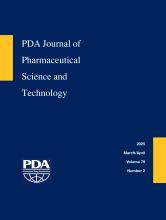Abstract
Filling of high-concentration/viscosity monoclonal antibody (mAb) formulations into vials or syringes by peristaltic pumps is an industrial standard. Control of the peristaltic pump on fill weight/volume accuracy/precision over time, however, has not been fully disclosed in the literature. This study systematically evaluated the impact of a broad range of system/pump parameters, from tubing set up to pump parameter settings to the filling nozzle, on filling precision using a bench-top system with fill weight readings from a high-precision balance. A low fill volume of 0.3 mL was targeted to fill liquids of various viscosities (including a high-concentration mAb formulation). Fill weight precision was reported via percent of fill weight data points (at least 100 consecutive points) falling within 3% of the target fill weight (e.g., within 0.009 g for a 0.3 g target fill weight). Experimental results suggested that the 3% precision target is challenging for filling high-viscosity liquids due to run-to-run and day-to-day variability. More importantly, none of the system/pump parameters seemed to directly correlate with fill weight precision. Photograph analysis revealed liquid suck-back height variations during fill, which correlated well with fill weight variability. Suck-back height variation was attributed to two possible root causes: (1) inconsistent liquid stream separation point and (2) pressure-induced variations upon suck-back. Liquid stream break-up was influenced by liquid properties as well as liquid/nozzle interactions, and pressure variations might be associated with tubing and overall mechanism of the peristaltic pump. A custom nozzle-tip design featuring a hydrophobic tip and a pressure-resistance barrier enabled consistent suck-back heights for each fill and approximately 90% of fill weight data within 3% precision for a high-concentration mAb formulation.
- Fill weight precision
- High concentration monoclonal antibody
- Liquid/nozzle interactions
- Peristaltic pump
- Suck-back
- Received September 28, 2015.
- Accepted December 22, 2015.
- Copyright © 2016, Parenteral Drug Association
PDA members receive access to all articles published in the current year and previous volume year. Institutional subscribers received access to all content. Log in below to receive access to this article if you are either of these.
If you are neither or you are a PDA member trying to access an article outside of your membership license, then you must purchase access to this article (below). If you do not have a username or password for JPST, you will be required to create an account prior to purchasing.
Full issue PDFs are for PDA members only.
Note to pda.org users
The PDA and PDA bookstore websites (www.pda.org and www.pda.org/bookstore) are separate websites from the PDA JPST website. When you first join PDA, your initial UserID and Password are sent to HighWirePress to create your PDA JPST account. Subsequent UserrID and Password changes required at the PDA websites will not pass on to PDA JPST and vice versa. If you forget your PDA JPST UserID and/or Password, you can request help to retrieve UserID and reset Password below.






